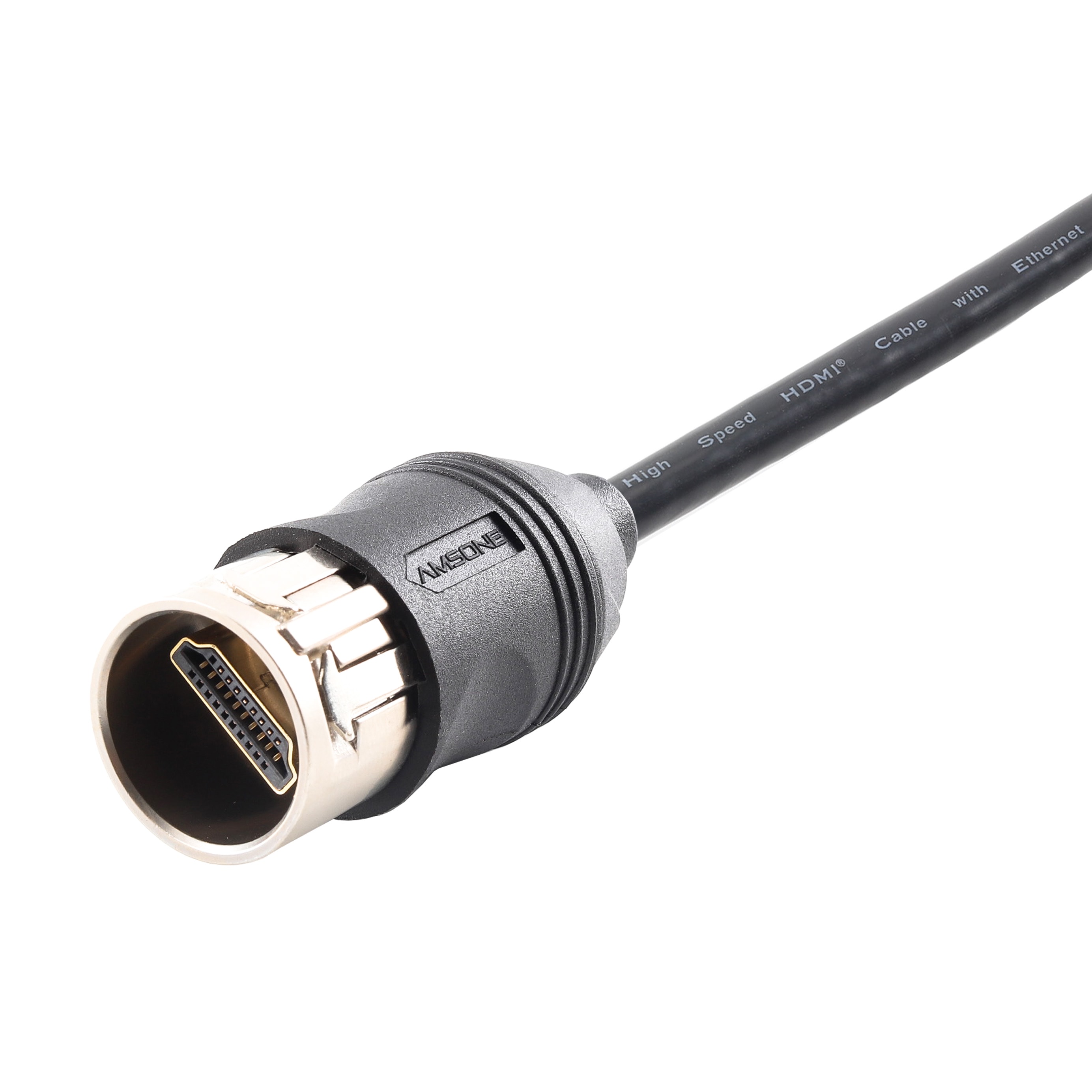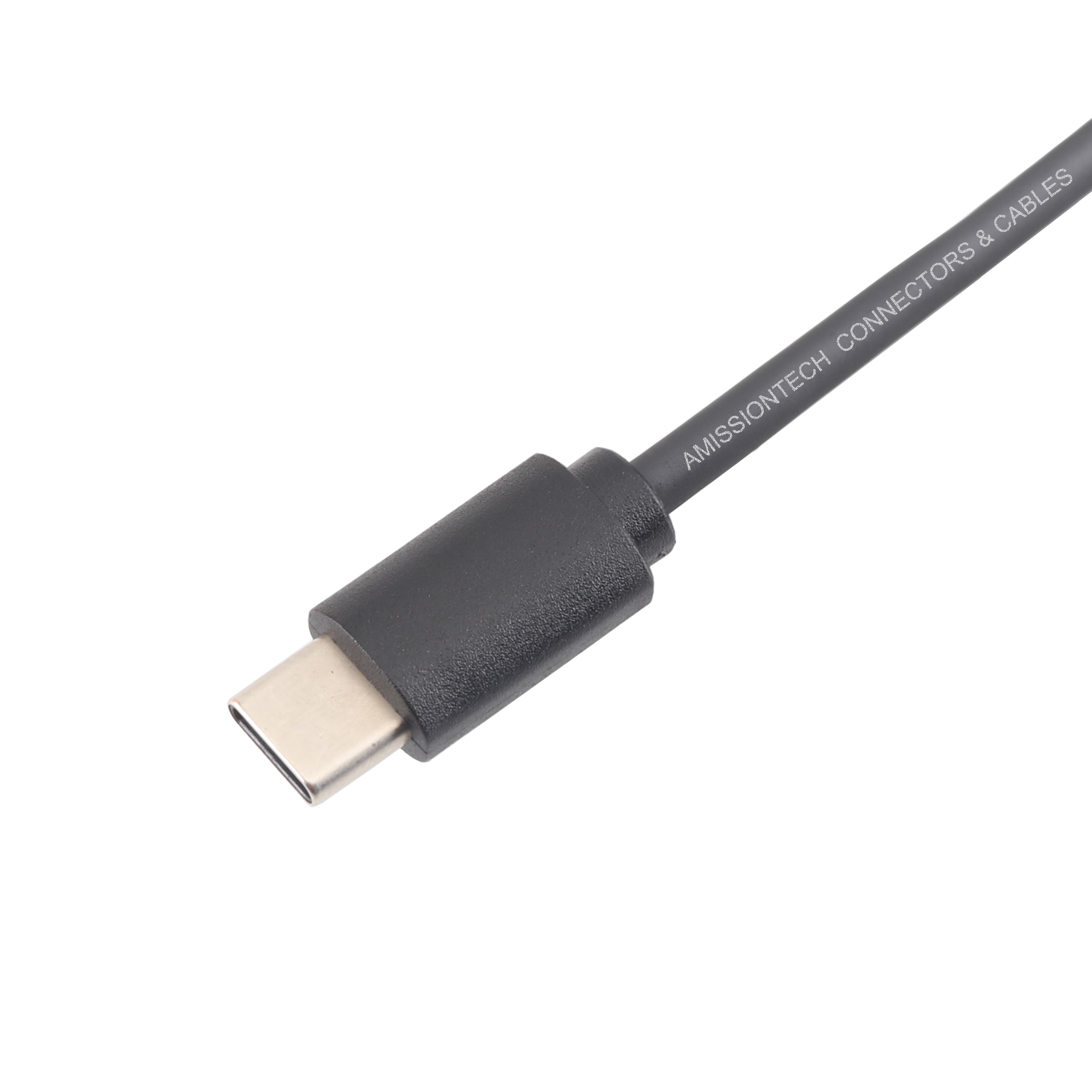Introduction
With the wide application of high-definition video and high-speed data transmission in industrial automation, energy systems, transportation hubs and other scenarios, HDMI (High-Definition Multimedia Interface) interface is gradually expanding from consumer electronics to the industrial field. However, the complex electromagnetic interference (EMI), frequent plugging and unplugging, strong vibration, moisture and dust infestation in industrial environments have put forward higher requirements for the stability and reliability of traditional HDMI cables.
In order to meet these stringent application requirements, industrial-grade HDMI cables in the material selection, structural design and connector process on the targeted optimization. Especially in the EMC shielding technology, multi-layer sheath structure, Push-Pull quick-insert structure, IP grade sealing design, etc., the formation of a new generation of connectivity solutions to adapt to the industrial environment. In this paper, we will systematically analyze the key shielding technology and structural optimization strategies used in industrial HDMI cables to help readers fully understand its technical evolution and practical application value.

The structure of the industrial HDMI cable composition and shielding basis
Compared with the common civilian field of lightweight HDMI cable, industrial HDMI cable in the structure and performance level pay more attention to the signal integrity, electromagnetic compatibility and mechanical strength. Its typical structure consists of the following layers:
1. Signal Conductor and Insulation Layer
Conductors: Silver-plated copper or oxygen-free copper for low-loss, high-consistency signal transmission.
Insulation: Foam PE or PTFE with low dielectric constants to minimize crosstalk and support high-frequency signals.
2. Multi-layer shielding structure
Aluminum foil shield: Blocks high-frequency EMI (first defense layer).
Copper braid shield: Mitigates low-frequency interference and reinforces structural strength.
Additional shielding: Metal braided outer mesh or EMI interlayers for enhanced performance.
3. Outer Sheath Layer
Materials such as PVC, TPE, TPU, etc. provide resistance to abrasion, oil, temperature and corrosion;
Some models have UV resistance or flame retardant rating, which is suitable for outdoor and high temperature places.
4. Industrial connector end design
Reinforced structure shell, using metal shell or reinforced plastic;
Additional EMC grounding shrapnel, conductive ring and other structures to ensure shielding continuity at the connection end;
Reserve protective sealing components to meet IP rating requirements.
These structures work together to make industrial HDMI cables maintain excellent signal integrity and system reliability in the face of strong interference and physical impact.
Push-Pull structure design and application advantages
In industrial environments, frequent replacement of equipment, test ports, high-intensity use is the norm, the traditional HDMI plug is difficult to meet the double requirements of the plug life and connection stability. Push-Pull (push-pull) quick-plug structure came into being, and has become one of the most important structural innovations in industrial HDMI cables.
1. Technical Principle
Push-Pull structure in the plug shell with additional elastic locking or release ring, so that the user can simply push or pull to realize the plugging and unplugging action.
Quick insertion, automatic locking, plugging and unplugging without rotating or bolts;
Releasing the latch when pulling out avoids cable damage caused by violent pulling;
Maintains the positioning accuracy of the plug and socket and the reliability of the electrical connection.
2. Application Advantages
Increased plugging and unplugging life: typically up to thousands of times, much higher than consumer grade HDMI plugs;
Convenient operation: one-handed quick plugging and unplugging, suitable for space-constrained occasions;
Good shielding continuity: under the insertion state, the shielding layer and the equipment ground system maintain complete conduction, better EMC performance;
Anti-vibration and anti-loosening: the mechanical locking structure enhances the anti-vibration ability, suitable for working conditions with mechanical vibration.
3. Application cases
Display signal interface in automated testing system;
Temporary test connection between industrial robots and control host;
High-frequency plugging and unplugging signal connection between medical imaging equipment and mobile terminals.
Push-Pull quick-plug structure effectively improves the operability and service life of industrial HDMI interface, which is one of the key configurations to adapt to the needs of complex applications.
Multiple EMC shielding technology: to ensure the core of signal integrity
industrial scenarios in a wide range of high-frequency motors, frequency converters, wireless communications and other sources of interference, HDMI signal as a high-speed serial transmission is very susceptible to electromagnetic interference (EMI), resulting in image distortion, signal packet loss or even communication interruption. Therefore, industrial HDMI cables need to integrate multiple EMC shielding technology in the design to ensure signal integrity and stability.
1. Layer-by-layer shielding structure design
Single core pair aluminum foil wrapping: Each differential signal pair is independently wrapped with aluminum foil to suppress crosstalk;
Integral Aluminum Foil + Woven Mesh: Multi-layer superimposed shielding structure to cover 0.1MHz~1GHz frequency band interference;
Shield grounding system: through the 360° conduction design at the connector end, the interference current is effectively diverted to the grounding system.
2. EMC consistency safeguard measures
Use high coverage (85% or more) copper woven mesh or tinned copper mesh to enhance the shielding capability against low frequency magnetic field interference;
The connector end adopts metal shell or conductive plastic with conductive foam / shrapnel structure to ensure shielding continuity;
The introduction of the overall grounding technology or shielding shell common ground design, to build a complete anti-interference barrier.
3. Testing and Certification
High-end industrial HDMI cables are usually tested for EMC compatibility (e.g., EN 55032, EN 61000-6-2, etc.) and verified for anti-interference in typical application scenarios to ensure that they are suitable for complex industrial electromagnetic environments.
Multiple shielding strategies not only ensure high fidelity transmission of image and audio signals, but also provide strong support for system-level EMC design.
Protection level and environmental adaptability: the embodiment of industrial reliability
In outdoor equipment, production lines or transportation systems and other use environments, HDMI cables may face the challenges of dust, water vapor, oil, high and low temperature impact and mechanical stress. Industrial HDMI cables incorporate a number of protection strategies in their design to enhance their environmental adaptability and service life.
1. IP rating structure
Common industrial HDMI connectors are designed to meet IP67 or higher ratings for water and dust resistance;
Effective sealing is achieved through O-ring seals, injection molded sealing sheaths, and threaded compression structures.
2. Weatherproof and Flame Retardant Materials
The outer sheath is made of oil- and acid-resistant TPU or TPE, which is suitable for oil and chemical corrosion environments in industrial sites;
The material meets UL94 V-0 flame retardant grade, which ensures that the cable does not promote combustion in fire scenarios;
Wide range of high and low temperature adaptation (-40℃~+85℃) to meet the application requirements of outdoor/cold chain/heat source scenarios.
3. Anti-tension and anti-bending design
internal addition of tensile fiber (such as Kevlar), armored steel wire or braided mesh reinforcement structure to prevent cable damage caused by prolonged dragging and bending;
It can support more than 100,000 times of dynamic bending life, adapting to high-frequency dynamic applications such as sports arms and rail systems.
These protective designs not only extend cable life, but also reduce the risk of equipment downtime due to interface failure.
Typical Application Scenarios and Development Trends
Industrial HDMI cables are widely used in industrial vision systems, human-machine interfaces (HMI), rail transportation, medical equipment, military command systems, and other occasions with stringent requirements for image transmission. Its excellent anti-interference ability, structural stability and environmental adaptability, making it a key component in the signal transmission link.
1. Typical application scenarios
Industrial automation: connecting industrial control host and touch display to ensure real-time stable display of control screen;
Security system: signal interface between high-definition video acquisition and transmission equipment;
Rail transportation: column control system, passenger information system (PIS) in the realization of anti-seismic connection;
Medical imaging: high-definition video output connection between devices such as ultrasound, endoscopy, CT, etc.;
Vehicle-mounted systems: vehicle-mounted information terminals for construction machinery or intelligent vehicles.
2. Technology Development Trends
Higher speed standard support: evolving to HDMI 2.1, supporting 8K video with higher frame rates;
More compact and flexible structure: to meet the needs of miniaturized equipment and dynamic cabling;
Intelligent cable identification and monitoring functions: integrated RFID or sensing components to achieve cable status monitoring;
Green material selection: adopting recyclable and low-pollution material system to meet RoHS, REACH and other environmental norms.
With the development of industrial informationization and intelligent manufacturing, the demand for high-definition signal transmission will continue to grow, with high shielding, strong protection and intelligent connectivity of industrial HDMI cable will play an increasingly important role.
Choose AMSONE to build a stable industrial signal connection system
AMSONE specializes in high-performance industrial connectivity solutions, providing multi-layer shielded, ruggedly protected, stable transmission HDMI shielded cables, which are widely used in harsh environments, such as automation, railroad, medical and so on. We support customization to meet the needs of various non-standard working conditions.

 EN
EN DE
DE JP
JP ES
ES SE
SE FR
FR IT
IT CN
CN 한국어
한국어 ภาษาไทย
ภาษาไทย بالعربية
بالعربية Nederlands
Nederlands Türkçe
Türkçe Język polski
Język polski Tiếng Việt
Tiếng Việt Zulu
Zulu Bahasa Malay
Bahasa Malay

